Experimental Study on Migration Characteristics and Profile Control Performance of Gel Foam in Fractured-Vuggy Reservoir
Abstract
1. Introduction
2. Results and Discussion
2.1. Study on Migration Behaviors in Vugs
2.1.1. Comparative Analysis of Migration Behaviors of Different Foam Systems in Vugs
2.1.2. Effect of Temperature on the Migration Behavior of Gel Foam
2.2. Profile Control Performance and Enhanced Oil Recovery Mechanism of Gel Foam in Fractured-Vuggy Network Model
2.2.1. Profile Control Characteristic of Gel Foam
2.2.2. Mechanism Analysis of Enhancing Oil Recovery by Gel Foam
- (1)
- Density regulation
- (2)
- Foam regeneration
- (3)
- Flow redirection
- (4)
- Stable plugging
- (5)
- Deep displacement by stable gel foam
2.3. Comparison with Previous Studies
3. Conclusions
- (1)
- Compared to ordinary foam and polymer foam, gel foam exhibited a lower liquid drainage rate, higher foam retention rate, larger sweep range, and stronger reservoir adaptability.
- (2)
- An increased temperature accelerated the thermal expansion of gas and changes in liquid film characteristics, which enhanced the migration speed and sweep range of gel foam. Within the temperature range of 30–100 °C, the drainage rate remained below 3%, the corresponding foam retention rate was above 97%.
- (3)
- Gel foam demonstrated a strong residual oil mobilization capacity. The displacement pressure difference in the subsequent gas flooding stage was 3.8 times that in the initial gas flooding stage, the oil recovery was 18.85% higher than that in the initial gas flooding stage, and the final recovery of the model reached 81.51%.
- (4)
- The relationship between displacement pressure difference, oil recovery data, and migration path was helpful to understand the mechanisms underlying enhanced gel foam oil recovery. The mechanisms include density regulation to sweep the middle of the reservoir, gas shear promoting foam regeneration, flow redirection to alter the gas migration path and expand the gas sweep range, maintaining long-term plugging, and gas and regenerated foam pushing stable gel foam deeper into the reservoir. These mechanisms work synergistically to achieve efficient plugging and enhance the recovery of residual oil.
4. Materials and Methods
4.1. Materials
4.2. Experimental Setup
4.3. Migration Experiment of Foam in Vuggy Model
- (1)
- The foaming base solution was put into the intermediate container. N2 was filled into the intermediate container and adjusted in real time, with the pressure kept at about 0.5 MPa. The pressure of the back pressure valve was set at 0.5 MPa. The experimental devices were connected according to Figure 14, and the camera was turned on to record the experimental process.
- (2)
- The gas–liquid volume ratio was maintained at 2:1, with N2 injected at a rate of 0.66 mL/min and the foaming solution injected at a rate of 0.33 mL/min. Foam was generated as the gas and solution passed through the foam generator. Once the foam output stabilized, it was connected to the experimental model. The total foam injection volume was 1 PV.
- (3)
- The experimental model was cleaned, the foam system was replaced, or the temperature was changed according to the experimental parameters shown in Table 2. Steps (1) and (2) were repeated until the experiment was completed.
4.4. Profile Control Experiment of Gel Foam in Fractured-Vuggy Network Model
- (1)
- The gel foam base solution was placed in the intermediate container, N2 was charged into the container, and the pressure was maintained at around 0.5 MPa. The back pressure valve pressure was set to 0.5 MPa. The visual experimental model (Figure 13b) was saturated with simulated oil, and the experimental pipelines were connected according to Figure 14. The model was kept vertically at all times, and the camera was turned on to record the experimental process.
- (2)
- Water was directly injected into the model using an ISCO pump, with injection rate of 1 mL/min and injection volume of 1 PV. The oil production volume and displacement pressure difference were recorded.
- (3)
- After waterflooding, gas was injected into the model at a speed of 1 mL/min, and the injection volume was 1 PV. The corresponding oil production volume was recorded.
- (4)
- The gas–liquid ratio was maintained at 2:1, with N2 injected at a rate of 0.5 mL/min and the gel foam base solution injected at a rate of 1 mL/min. Foam was generated when the gas and solution passed through the foam generator. Once the foam output stabilized, it was connected to the experimental setup, with a foam injection volume of 0.4 PV. The oil production volume and displacement pressure difference were recorded.
- (5)
- After foam injection, gas continued to be injected into the model at a rate of 1 mL/min, with an injection volume of 0.5 PV. The oil production volume and displacement pressure difference were recorded.
Author Contributions
Funding
Data Availability Statement
Acknowledgments
Conflicts of Interest
References
- Zou, C.; Zhi, Y.; Zhu, R.; Zhang, G.; Hou, L.; Wu, S.; Tao, S.; Yuan, X.; Dong, D.; Wang, Y.; et al. Progress in China’s unconventional oil & gas exploration and development and theoretical technologies. Acta Geol. Sin. (Engl. Ed.) 2015, 89, 938–971. [Google Scholar]
- Li, G.; Zhu, R. Progress, challenges and key issues in the unconventional oil and gas development of CNPC. China Pet. Explor. 2020, 25, 1–13. [Google Scholar]
- Zheng, S.; Yang, M.; Kang, Z.; Liu, Z.; Long, X.; Liu, K.; Li, X.; Zhang, S. Controlling factors of remaining oil distribution after water flooding and enhanced oil recovery methods for fracture-cavity carbonate reservoirs in Tahe Oilfield. Pet. Explor. Dev. 2019, 46, 786–795. [Google Scholar] [CrossRef]
- Li, Y.; Kang, Z.; Xue, Z.; Zheng, S. Theories and practices of carbonate reservoirs development in China. Pet. Explor. Dev. 2018, 45, 712–722. [Google Scholar] [CrossRef]
- Dai, C.; Fang, J.; Jiao, B.; He, L.; He, X. Development of the research on EOR for carbonate fractured-vuggy reservoirs in China. J. China Univ. Pet. Ed. Nat. Sci. 2018, 42, 67–78. [Google Scholar]
- Lu, G.; Zhang, L.; Liu, Q.; Xu, Q.; Zhao, Y.; Li, X.; Deng, G.; Wang, Y. Experiment analysis of remaining oil distribution and potential tapping for fractured-vuggy reservoir. J. Pet. Sci. Eng. 2022, 208, 109544. [Google Scholar] [CrossRef]
- Jiao, F. Practice and knowledge of volumetric development of deep fractured-vuggy carbonate reservoirs in Tarim Basin, NW China. Pet. Explor. Dev. 2019, 46, 576–582. [Google Scholar] [CrossRef]
- Zheng, L.; Zhu, B.; Zhang, Y.; Li, X.; Peng, J.; Xiao, W. Types and applicability of waterflooding characteristic curves in fractured-cavity carbonate reservoirs: A case study of Tahe Oilfield. Pet. Reserv. Eval. Dev. 2024, 14, 899–907. [Google Scholar]
- Xiao, Y.; Zhang, Z.; Jiang, T.; Cai, Z.; Deng, X.; Zhou, J. Dynamic and static combination method for fracture-vug unit division of fractured-vuggy reservoirs. Arab. J. Sci. Eng. 2018, 43, 2633–2640. [Google Scholar] [CrossRef]
- Guo, W.; Fu, S.; Li, A.; Xie, H.; Cui, S.; Nangendo, J. Experimental research on the mechanisms of improving water flooding in fractured-vuggy reservoirs. J. Pet. Sci. Eng. 2022, 213, 110383. [Google Scholar] [CrossRef]
- Yuan, S.; Liu, W.; Jiang, H.; Zhao, L.; Wang, J. Investigation into development modes of fracture-cavity carbonate reservoirs based on reservoir characteristics. Pet. Geol. Recovery Effic. 2021, 28, 80–87. [Google Scholar]
- Zhao, Y.; Lu, G.; Zhang, L.; Yang, K.; Li, X.; Luo, J. Physical simulation of waterflooding development in large-scale fractured-vuggy reservoir considering filling characteristics. J. Pet. Sci. Eng. 2020, 191, 107328. [Google Scholar] [CrossRef]
- Guo, W.; Huang, Z.; Li, A.; An, G.; Cui, S. Visual experiments of bottom water and multi-well water and gas injection flooding for fault-controlled fractured-vuggy reservoirs. Phys. Fluids 2023, 35, 083319. [Google Scholar] [CrossRef]
- Song, Z.; Li, M.; Zhao, C.; Yang, Y.; Hou, J. Gas injection for enhanced oil recovery in two-dimensional geology-based physical model of Tahe fractured-vuggy carbonate reservoirs: Karst fault system. Pet. Sci. 2020, 17, 419–433. [Google Scholar] [CrossRef]
- Lyu, X.; Liu, Z.; Hou, J.; Lyu, T. Mechanism and influencing factors of EOR by N2 injection in fractured-vuggy carbonate reservoirs. J. Nat. Gas Sci. Eng. 2017, 40, 226–235. [Google Scholar] [CrossRef]
- Wen, Y.; Hou, J.; Xiao, X.; Li, C.; Qu, M.; Zhao, Y.; Zhong, W.; Liang, T.; Wu, W. Utilization mechanism of foam flooding and distribution situation of residual oil in fractured-vuggy carbonate reservoirs. Pet. Sci. 2023, 20, 1620–1639. [Google Scholar] [CrossRef]
- Wang, L.; Wang, T.; Wang, J.; Tian, H.; Chen, Y.; Song, W. Enhanced oil recovery mechanism and technical boundary of gel foam profile control system for heterogeneous reservoirs in Changqing. Gels 2022, 8, 371. [Google Scholar] [CrossRef]
- Lai, N.; Yuan, L.; Li, W.; Xiong, W.; Yu, G.; Du, Z.; Song, Z.; Wen, Y. Research on the properties of natural gas foamed gel as a profile control and an oil displacement agent in strong heterogeneous reservoirs. Energy Fuels 2021, 35, 7738–7755. [Google Scholar] [CrossRef]
- Yang, H.; Xu, Z.; Zhao, Y.; Zhang, B.; Cui, W.; Kang, W.; Qi, J.; Tang, Z.; Xu, P. A strong stability gel foam for water shutoff during oil and gas reservoir development. Phys. Fluids 2024, 36, 027133. [Google Scholar] [CrossRef]
- Wu, Q.; Ding, L.; Zhang, L.; Ge, J.; Rahman, M.A.; Economou, I.G.; Guérillot, D. Polymer enhanced foam for improving oil recovery in oil-wet carbonate reservoirs: A proof of concept and insights into the polymer-surfactant interactions. Energy 2023, 264, 126256. [Google Scholar] [CrossRef]
- Chen, Q.; Liu, D.; Nie, X.; Wang, D.; Pu, W.; Wei, B. Influence of Different Reservoir Conditions on the Stability and Decay Mechanism of the Polymer-Enhanced Foam. Energy Fuels 2024, 38, 961–978. [Google Scholar] [CrossRef]
- Yang, Z.; Luo, Z.; Lin, M.; Lyu, Q.; Li, X. Preparation of Temperature resistant foam gel system for improving CO2 gas flooding effect in low permeability reservoir. Oilfield Chem. 2020, 37, 86–92. [Google Scholar]
- Song, R.; Jiang, G.; Wang, K. Gelation mechanism and rheological properties of polyacrylamide crosslinking with polyethyleneimine and its plugging performance in air-foam displacement. J. Appl. Polym. Sci. 2018, 135, 45778. [Google Scholar] [CrossRef]
- Li, T.; Fang, J.; Jiao, B.; He, L.; Dai, C.; You, Q. Study on a novel gelled foam for conformance control in high temperature and high salinity reservoirs. Energies 2018, 11, 1364. [Google Scholar] [CrossRef]
- Fan, X.; Zhou, J.; Zhou, Y.; Zhang, J.; Zhang, X. An experimental of “enhanced foam + gel” flooding in high salinity reservoirs. J. Southwest Pet. Univ. Sci. Technol. Ed. 2024, 46, 159–168. [Google Scholar]
- Zou, C.; Liu, Y.; Dai, C.; Yuan, X.; Wang, H.; Huang, Y.; Xu, Z.; Yang, N. Salt-induced dual network gel-strengthened foam for gas channeling control in fractured-cavity carbonate reservoirs. Geoenergy Sci. Eng. 2025, 253, 213975. [Google Scholar] [CrossRef]
- Chen, L.; Huang, M.; Li, Z.; Liu, D.; Li, B. Experimental study on the characteristics of foam flow in fractures. J. Pet. Sci. Eng. 2020, 185, 106663. [Google Scholar] [CrossRef]
- Tang, Y.; Hou, C.; He, Y.; Tang, J.; Wang, Y.; Qin, J. Microscopic flow characteristics of immiscible CO2 flooding and CO2 foam flooding after water flooding in fractured porous media: A visual investigation. Transp. Porous Media 2023, 149, 117–145. [Google Scholar] [CrossRef]
- Buchgraber, M.; Castanier, L.M.; Kovscek, A.R. Microvisual Investigation of Foam Flow in Ideal Fractures: Role of Fracture Aperture and Surface Roughness. In Proceedings of the SPE Annual Technical Conference and Exhibition, San Antonio, TX, USA, 8–10 October 2012. [Google Scholar]
- Zhang, J.; Li, B.; Xin, Y.; Li, B.; Zhang, M.; Wang, H.; Zhang, S.; Zhang, H.; Gu, X. Preparation and characterization of high-stability gel foam for fracture plugging in reservoirs. Phys. Fluids 2024, 36, 093319. [Google Scholar] [CrossRef]
- Han, C.; Nie, S.; Zhang, H.; Chen, C. Study on highly stable biomass gel foam with ultra-strong film-forming performance based on the double network structure to inhibit coal spontaneous combustion. Combust. Sci. Technol. 2025, 197, 1426–1442. [Google Scholar] [CrossRef]
- Bai, Y.; Lian, Y.; Zhao, J.; Cao, Z.; Sun, J.; Zhang, H. Thermal-insulation and temperature-resistant foamed gel for thermal management of heavy oil steam flooding. J. Mol. Liq. 2022, 359, 119304. [Google Scholar] [CrossRef]
- Shi, Q.; Qin, B.; Xu, Y.; Hao, M.; Shao, X.; Zhuo, H. Experimental investigation of the drainage characteristic and stability mechanism of gel-stabilized foam used to extinguish coal fire. Fuel 2022, 313, 122685. [Google Scholar] [CrossRef]
- Qu, M.; Hou, J.; Wen, Y.; Liang, T. Nitrogen gas channeling characteristics in fracture-vuggy carbonate reservoirs. J. Pet. Sci. Eng. 2020, 186, 106723. [Google Scholar] [CrossRef]
- Wu, M.; Li, B.; Ruan, L.; Tang, Y.; Li, Z. Study on the Control of Steam Front Mobility in High-Temperature and High-Salinity Conditions Using Polymer-Enhanced Foam. Polymers 2024, 16, 2478. [Google Scholar] [CrossRef]
- Tao, L.; Sun, Z.; Zhang, L.; Zhang, N. Performance evaluation of a novel stable foam in high-temperature and high-salinity reservoir of the Shengli Oilfield. Pet. Sci. Technol. 2024, 42, 2976–2989. [Google Scholar] [CrossRef]
- Xu, Z.; Li, Z.; Cui, S.; Li, B.; Chen, D.; Zhang, Q.; Zheng, L.; Husein, M.M. Flow characteristics and EOR mechanism of foam flooding in fractured vuggy reservoirs. J. Pet. Sci. Eng. 2022, 211, 110170. [Google Scholar] [CrossRef]
- Liang, T.; Hou, J.; Qu, M.; Song, C.; Li, J.; Tan, T.; Lu, X.; Zheng, Y. Flow behaviors of nitrogen and foams in micro-visual fracture-vuggy structures. RSC Adv. 2021, 11, 28169–28177. [Google Scholar] [CrossRef]
- Li, B.; Zhang, J.; Zhang, Q.; He, L.; Wang, J.; Feng, Y. Static evolution and flow characteristics of foam in fractures. Colloids Surf. A 2024, 698, 134557. [Google Scholar] [CrossRef]
- Yang, J.; Hou, J.; Qu, M.; Liang, T.; Wen, Y. Experimental study the flow behaviors and mechanisms of nitrogen and foam assisted nitrogen gas flooding in 2-D visualized fractured-vuggy model. J. Pet. Sci. Eng. 2020, 194, 107501. [Google Scholar] [CrossRef]
- Wen, Y.; Hou, J. Experimental study on multi-dimensional visualization simulation of gas and gel foam flooding in fractured-vuggy reservoirs. Gels 2023, 9, 722. [Google Scholar] [CrossRef]
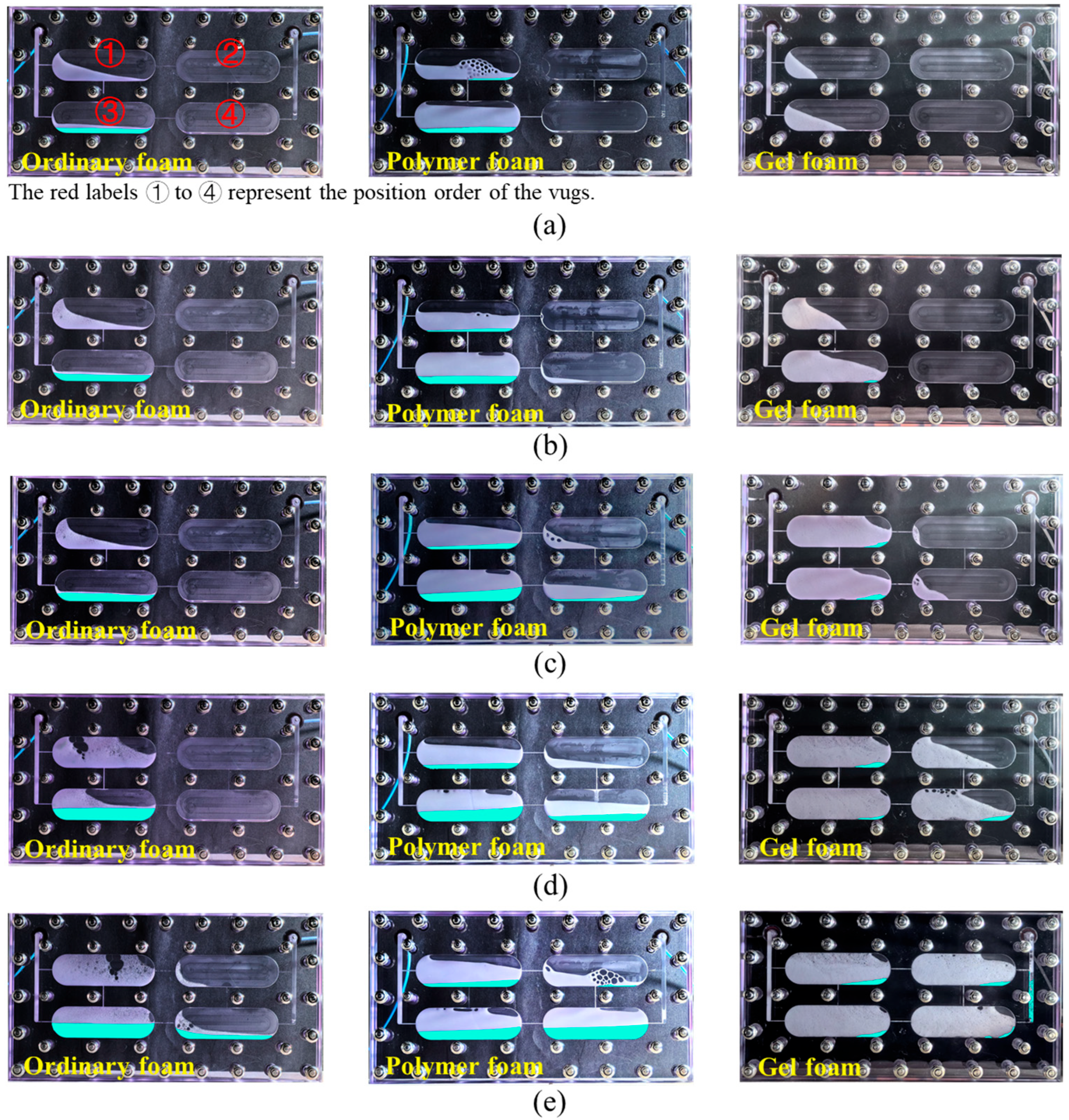
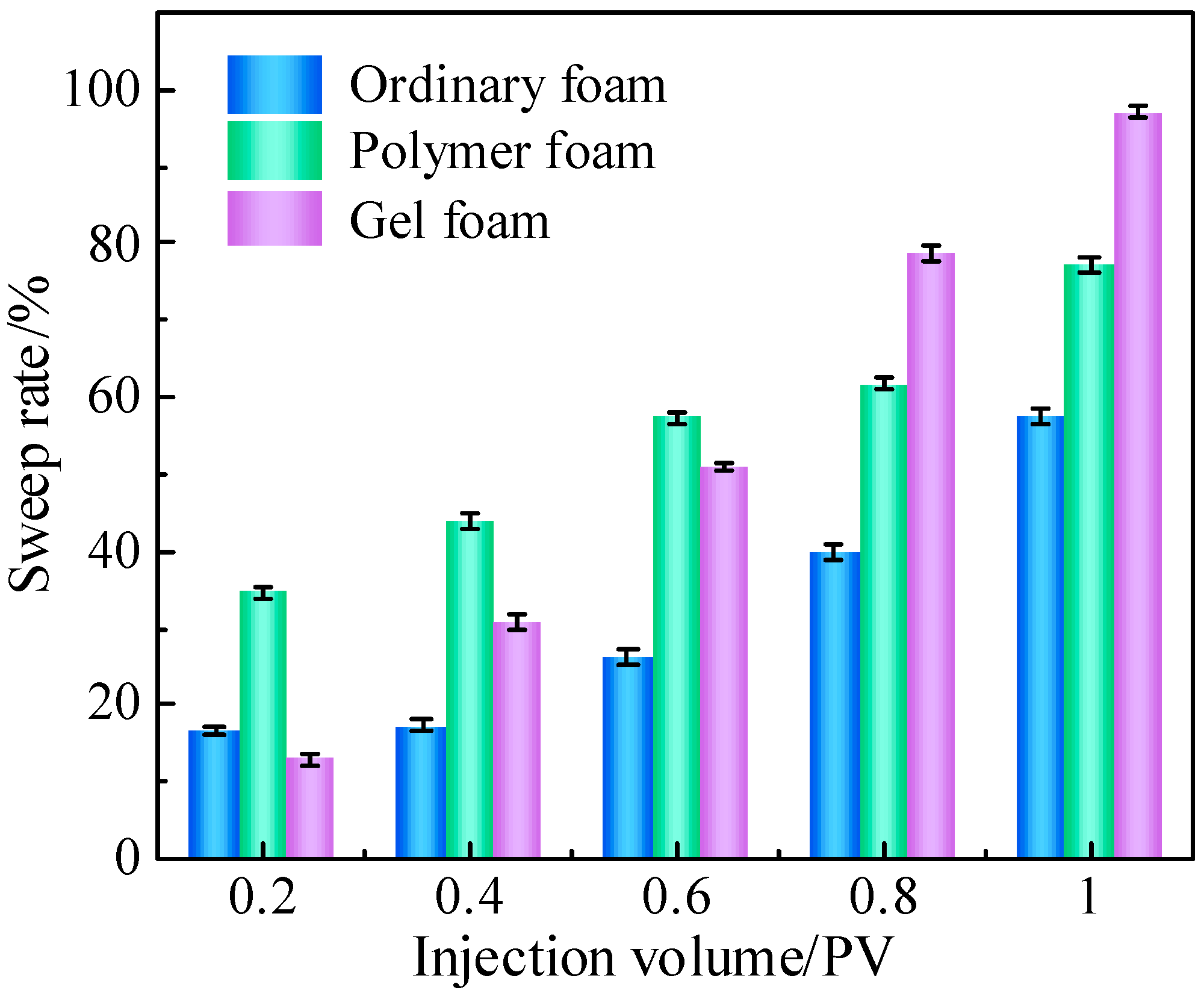
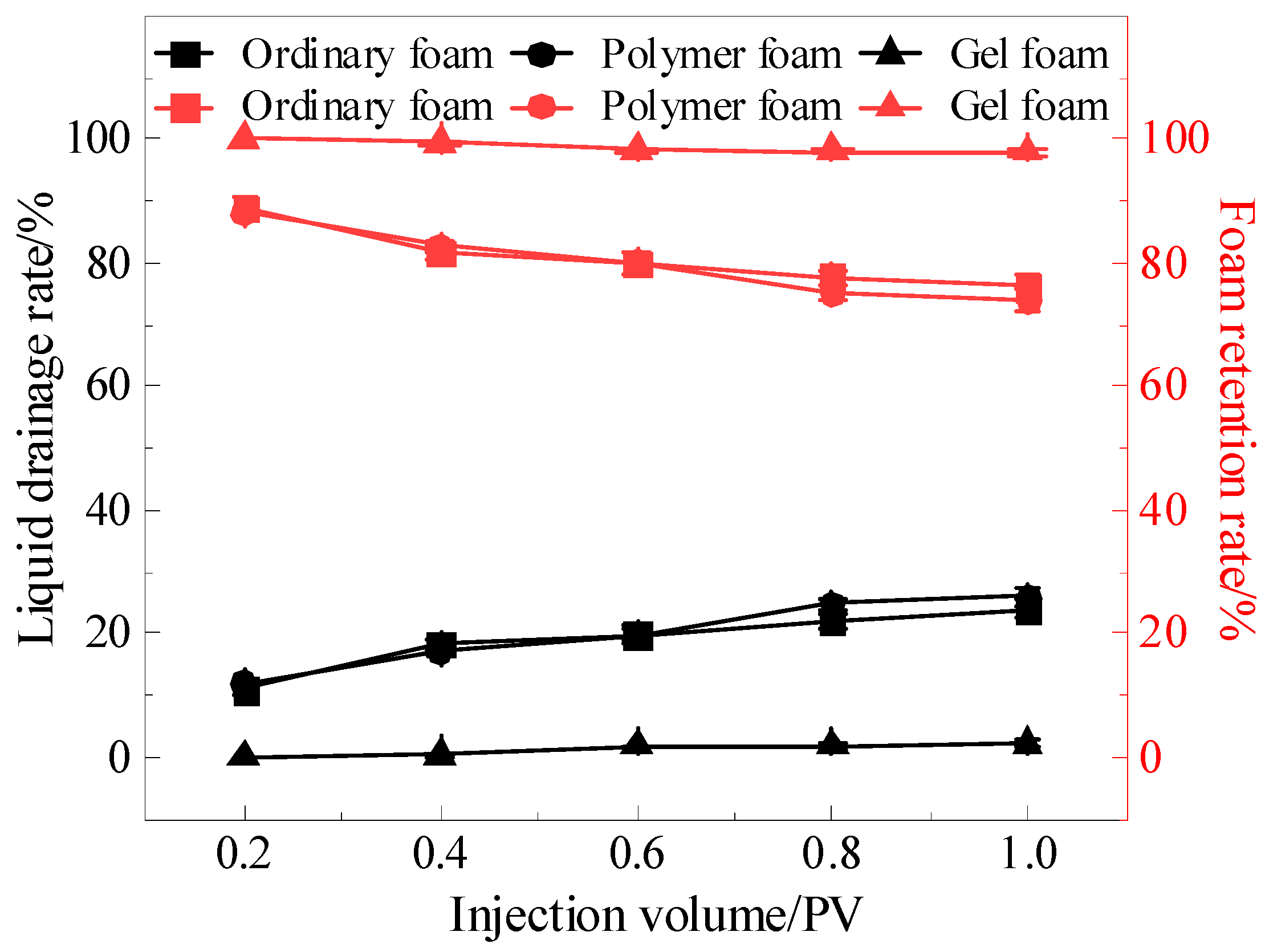
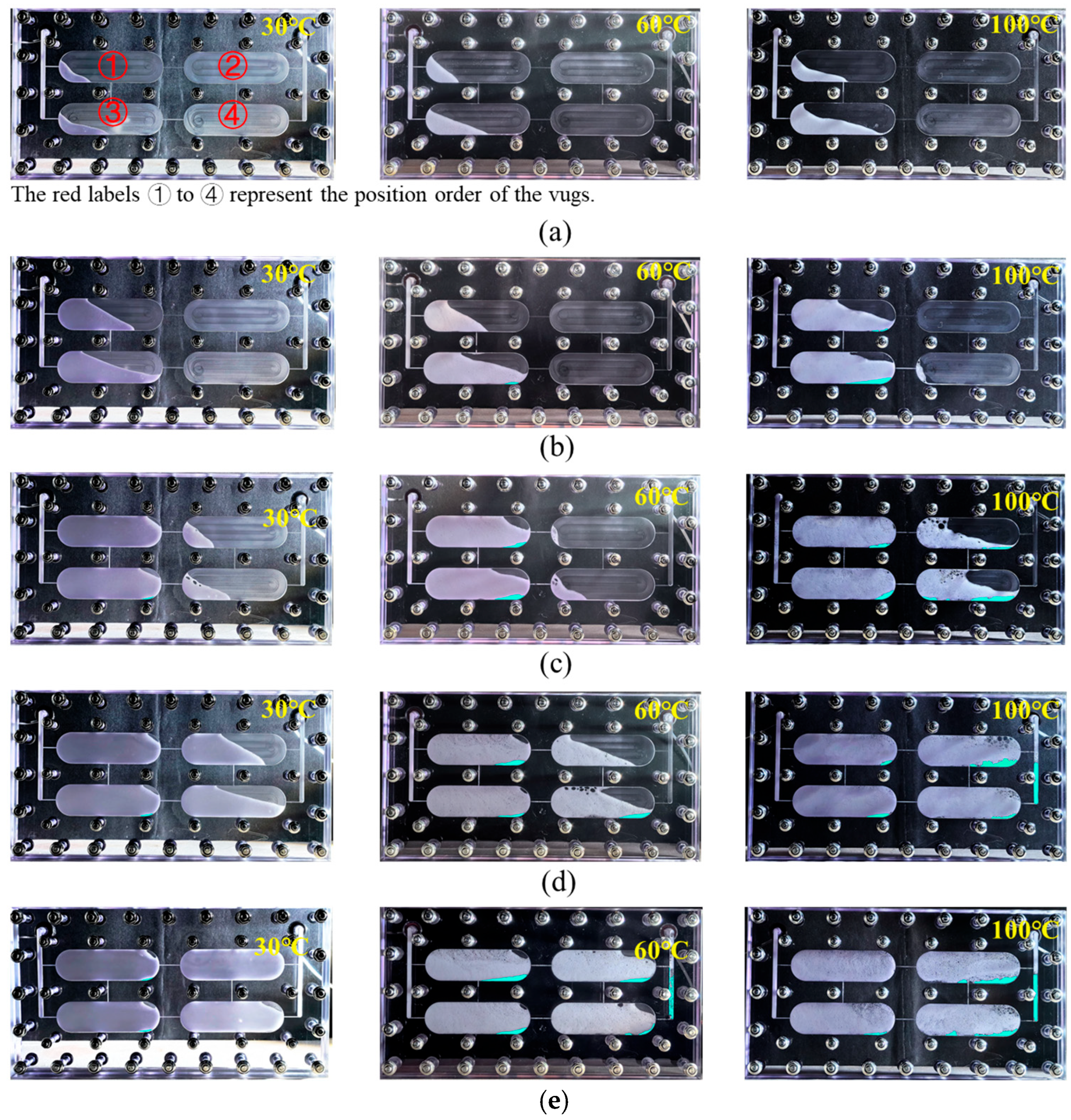
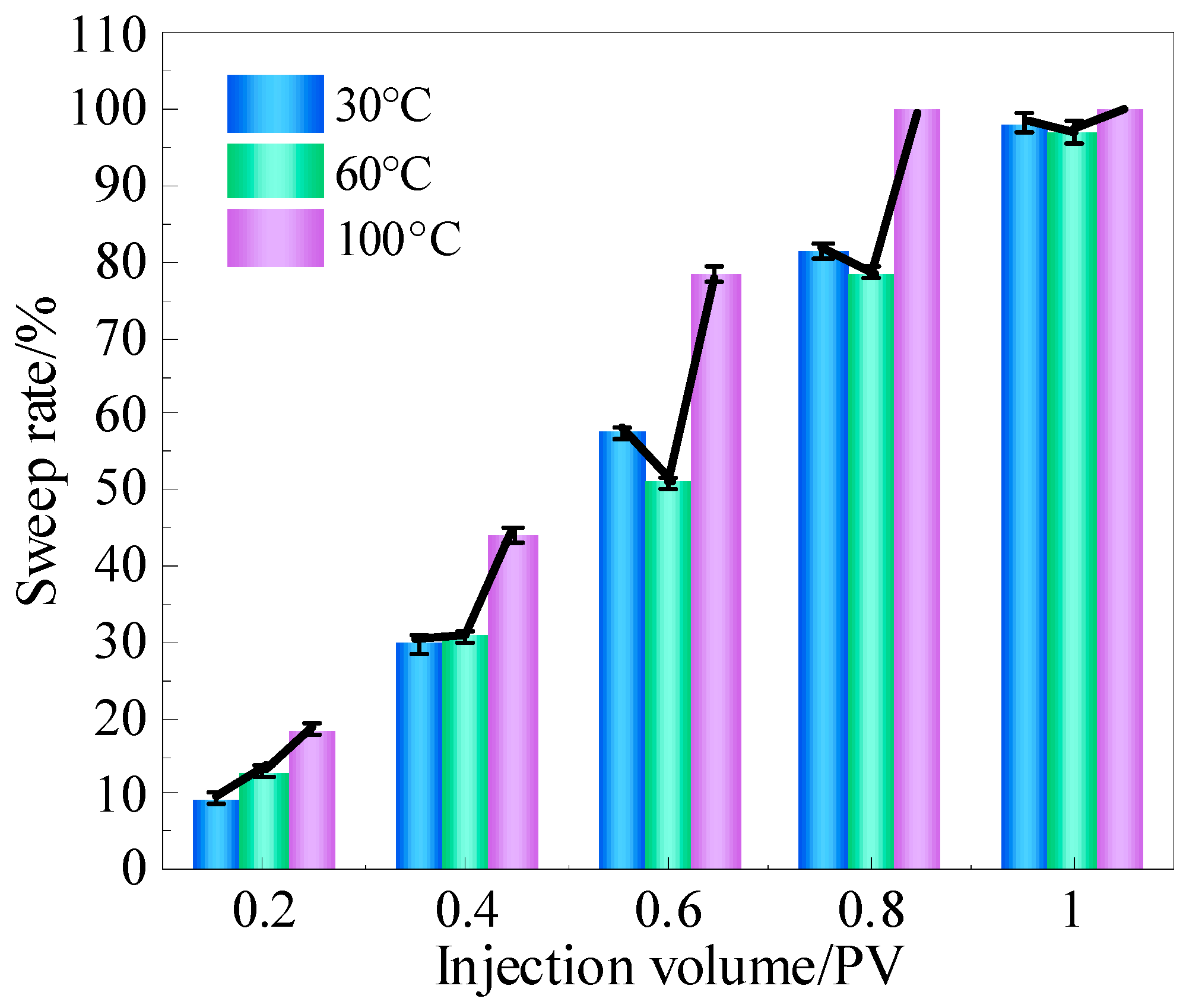
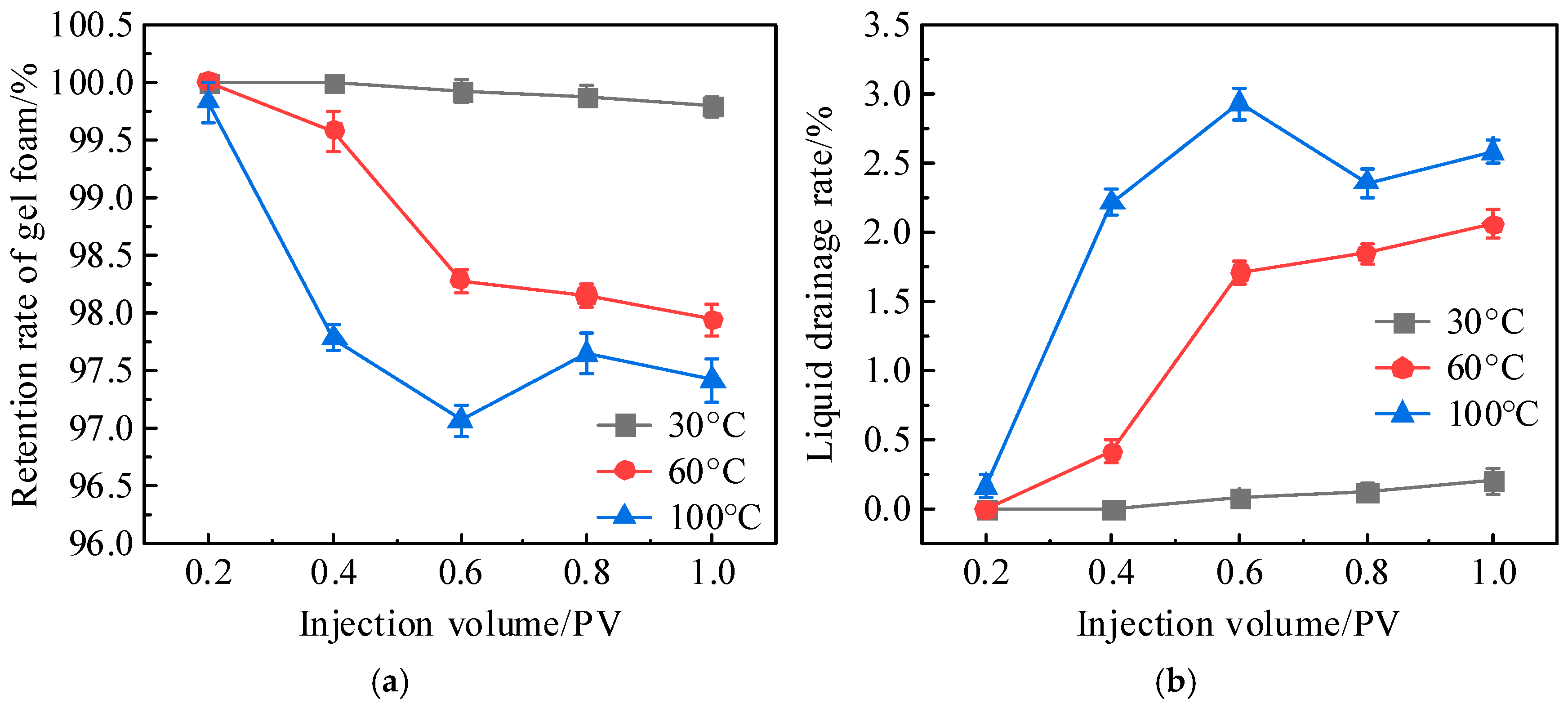



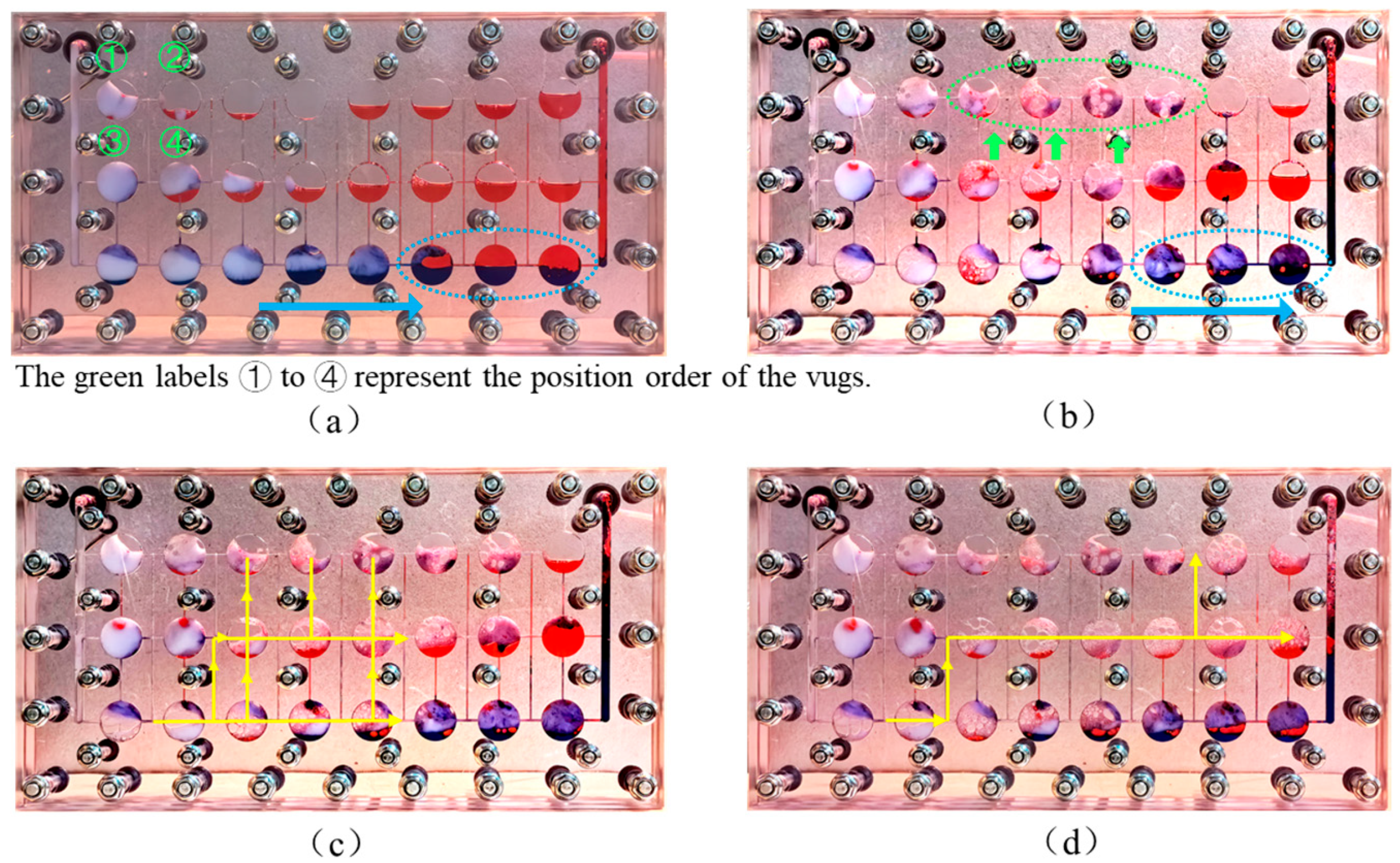
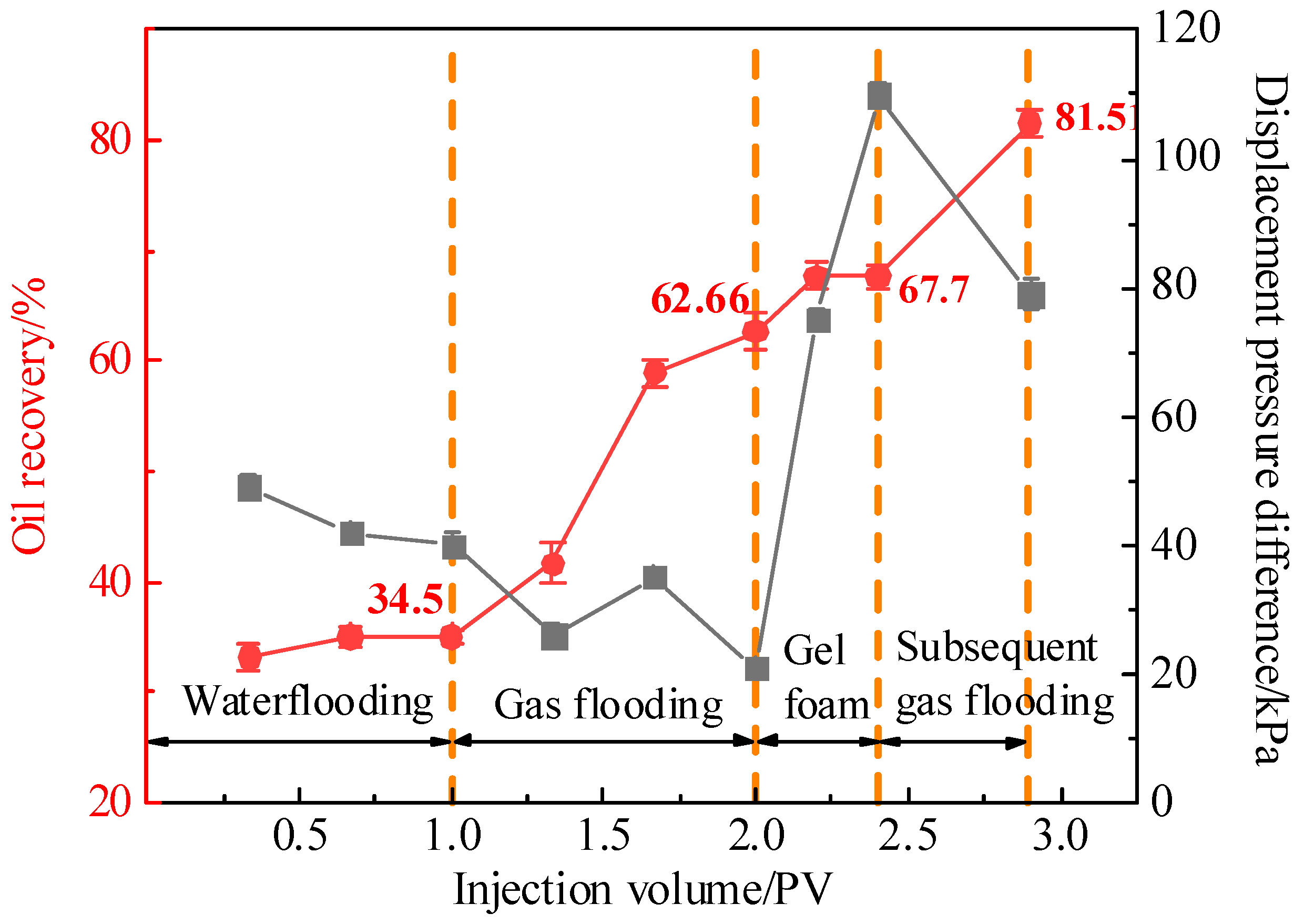


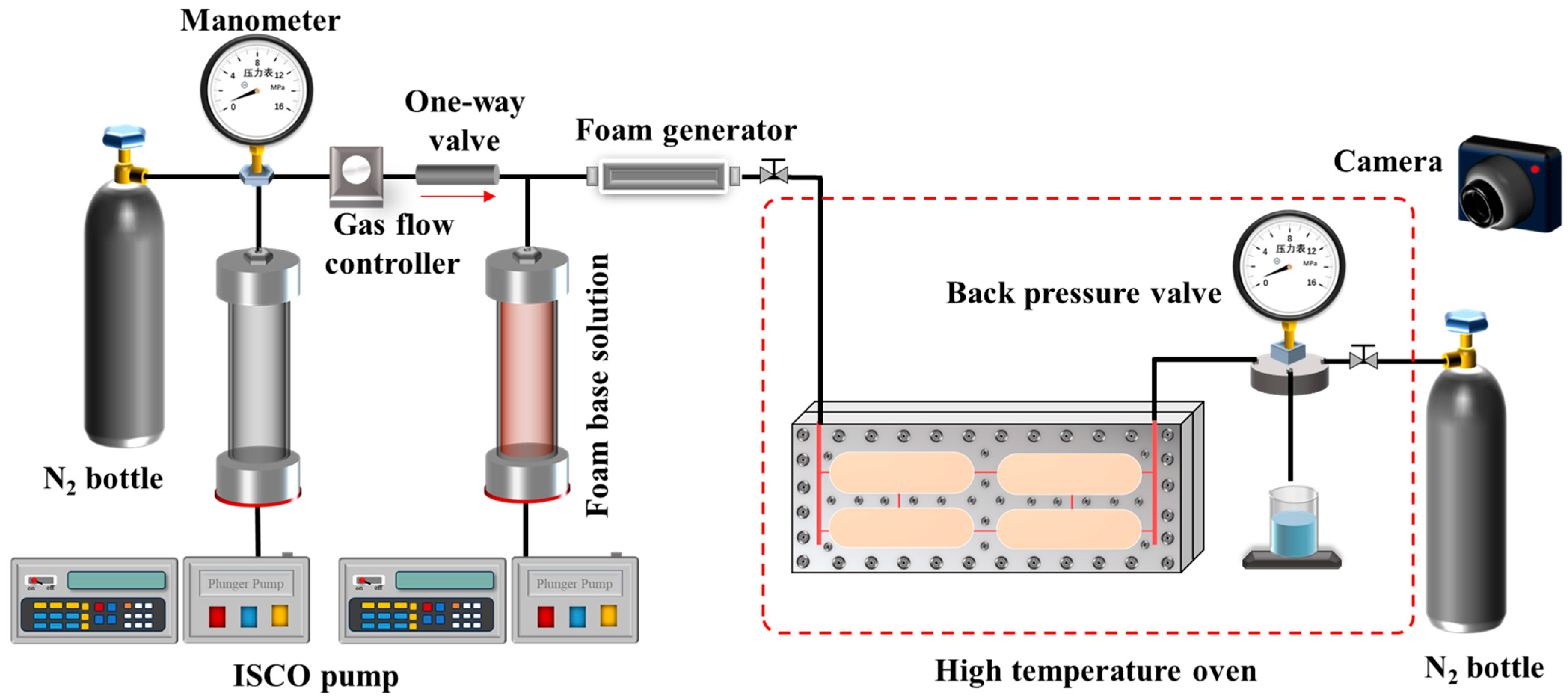
| Study | Foam Type | Experimental Temperature Range | Main Findings |
|---|---|---|---|
| Liang et al. [37] | Ordinary foam | 20 °C | Dynamic flow behavior and particle size change mechanism of foam in micro fracture-vuggy structures |
| Xu et al. [38] | Ordinary foam | 60 °C | Static distribution and coalescence characteristics of foam in the fractures and the cavern of the microetched model |
| Li et al. [39] | Ordinary foam | 20 °C | Foam generation, propagation and mobility characteristics in visualized fracture models. in fractures |
| Yang et al. [40] | Polymer foam | 25 °C | Flow behavior of foam-assisted nitrogen flooding in two-dimensional visual fracture-vuggy model and main EOR mechanism |
| Wen et al. [41] | Gel foam | 20 °C | Flow behavior of foam in visible fracture-vuggy model from one-dimensional to three-dimensional |
| Current work | Ordinary foam Polymer foam Gel foam | 30–100 °C | The difference of foam migration characteristics in vugs under the influence of different foam types and temperatures, EOR mechanism of gel foam in fractured-vuggy reservoirs |
| Foam System | Temperature/°C | Injection Rate/(mL/min) | Injection Volume/PV |
|---|---|---|---|
| Ordinary foam | 60 | 1 | 1 |
| Polymer foam | |||
| Gel foam | |||
| Gel foam | 30 | 1 | 1 |
| 60 | |||
| 100 |
Disclaimer/Publisher’s Note: The statements, opinions and data contained in all publications are solely those of the individual author(s) and contributor(s) and not of MDPI and/or the editor(s). MDPI and/or the editor(s) disclaim responsibility for any injury to people or property resulting from any ideas, methods, instructions or products referred to in the content. |
© 2025 by the authors. Licensee MDPI, Basel, Switzerland. This article is an open access article distributed under the terms and conditions of the Creative Commons Attribution (CC BY) license (https://creativecommons.org/licenses/by/4.0/).
Share and Cite
Xin, Y.; Li, B.; Zhang, J.; Wang, B.; Liu, A.; Li, Z. Experimental Study on Migration Characteristics and Profile Control Performance of Gel Foam in Fractured-Vuggy Reservoir. Gels 2025, 11, 768. https://doi.org/10.3390/gels11100768
Xin Y, Li B, Zhang J, Wang B, Liu A, Li Z. Experimental Study on Migration Characteristics and Profile Control Performance of Gel Foam in Fractured-Vuggy Reservoir. Gels. 2025; 11(10):768. https://doi.org/10.3390/gels11100768
Chicago/Turabian StyleXin, Yan, Binfei Li, Jingyu Zhang, Bo Wang, Aojue Liu, and Zhaomin Li. 2025. "Experimental Study on Migration Characteristics and Profile Control Performance of Gel Foam in Fractured-Vuggy Reservoir" Gels 11, no. 10: 768. https://doi.org/10.3390/gels11100768
APA StyleXin, Y., Li, B., Zhang, J., Wang, B., Liu, A., & Li, Z. (2025). Experimental Study on Migration Characteristics and Profile Control Performance of Gel Foam in Fractured-Vuggy Reservoir. Gels, 11(10), 768. https://doi.org/10.3390/gels11100768







